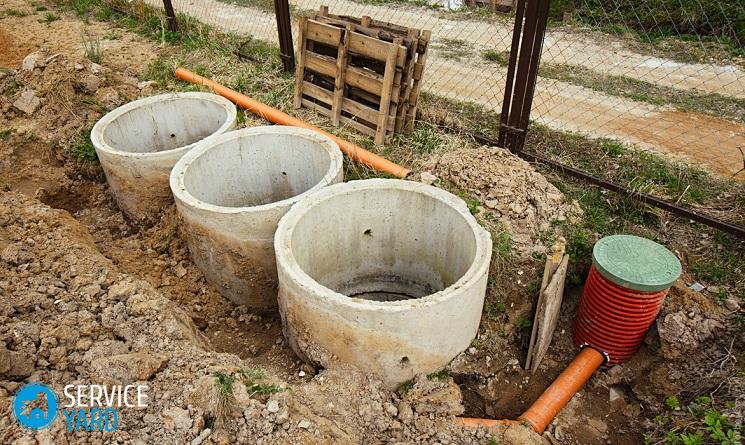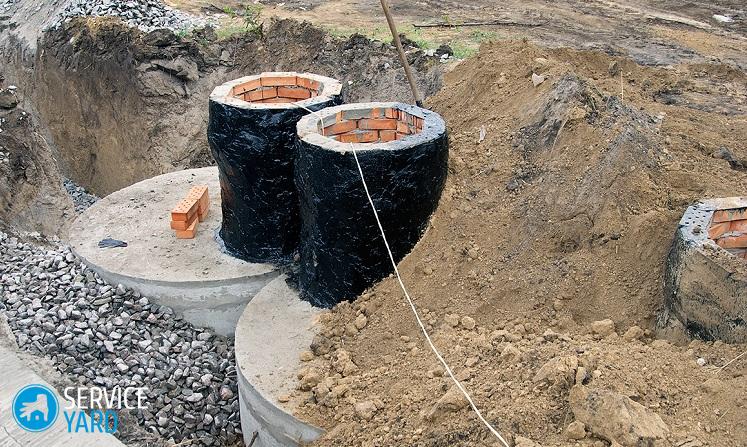Do-it-yourself well made of concrete rings

A summer cottage without a water source does not look quite full. Of course, there are situations when the whole street takes water from a common column or from a spring, but this is not always convenient. It’s better to try to find a source on your territory, and you can arrange it in different ways. To make a well with concrete do-it-yourself rings is quite affordable even for a beginner summer resident. Read about it in our article.
to contents ↑Where to looking for?
Before you make a well from concrete rings, you need to take an equally important step - try to find water on your site. Not everyone can afford to drill several exploratory wells. Although such an option is also possible - a prefabricated drilling rig can be rented. But before deciding on such a crucial step, you can try other ways:
- Ask the neighbors where the water comes from in their wells.
- Do not forget to ask at what depth they found water, and also how much the construction of the well cost.
If your summer cottage partnership is located on relatively flat terrain, and all sections are approximately at the same geodetic mark, this will be enough. It is another matter if the territory is hilly or some sections are located directly on the banks of a river or stream - the data received from neighbors can be very inaccurate. Have to use folk methods.
Popular signs for determining the source of water
One of the signs is the presence of “witch panicles” on the trees. They are always there when the tree stands above the watercourse. This is especially noticeable on birches. In addition, the birch trees themselves, which grow where the water comes close to the surface, usually do not look as attractive as their “sisters” in other places - they are low and curved.
Important! Some plants can tell the place of the future well. For example, river gravilate always grows where water is close.
Banks will help you out
A place for the future well can be found in another way. For it, you will need a dozen and a half glass jars and dry weather:
- Place the cans upside down in different corners of the plot on a dry evening.
- Make sure that they stand tight, there are no gaps between the soil and the necks.
- In the morning, look at the dew inside which cans - in this place the source of water is quite close.
How to arrange?
If you are lucky and the source is close enough to the surface - you can start digging. An acceptable distance is 15-20 m. Building standards allow a depth of up to 30 m, however, the process of constructing a well is too laborious and expensive.
to contents ↑Important! Of course, there are situations when there is simply no other way out. In this case, it is better to invite drillers with special equipment - it will be both easier and cheaper than lifting the soil to the surface from a 30-meter depth.
What is water for?
The question may seem strange, but in fact, there is nothing unusual in it. Well water can be used in different ways, and sanitary requirements, as well as the depth of the well itself, depend on this. Water is needed:
- for watering;
- for a bath;
- for a drink.
If you intend to use water for irrigation or for a bath, sanitary requirements will be less stringent than for drinking. Depth can be only 5-7 m. Drinking water is taken from deeper layers. But in any case, you will need the conclusion of the SES.
Important! The upper layer, which is also called the upper layer, is suitable only for technical purposes, since it is very clogged.
Some more conditions
Even if the watercourse is close and theoretically the well can be located anywhere, there are some considerations to consider:
- The water source should be located as far as possible from possible pollutants - it is better to place it at a distance of 25-50 m.
- The distance from the foundation of the house should not be less than 8 m.
- It is better to place it at the highest point in the direction of flow.
Sources of pollution
These include some objects that are almost inevitable in rural areas. Close to the well should not be:
- landfills:
- compost heaps;
- car washes;
- places of discharge of liquid waste, cesspools.
Take care of the foundation
The well should not be placed close to the house. Otherwise, groundwater will begin to wash away the rocks under the foundation, and the house will not stand idle for a long time. The place where the water intake is located should be:
- clean
- dry
- at a slight elevation.
When to start work?
It is best to equip a well in late autumn - unless, of course, you live in a region where it is before winter that has the least amount of rainfall. During this period, the water level is minimal. Could do this in the winter, if we proceed only from these considerations. But after the frosts hit, the top meter of soil will be quite difficult to remove. In addition, if the earth freezes, the natural shrinkage of the elements of the well will be difficult.
to contents ↑Important! In summer and spring, you should not dig a well because the water level reaches a maximum. There is a great risk of making the mine too small. As a result, in the fall and winter, you simply risk being left without water at all.
What to do?
In modern cottage villages, you can see two types of wells:
- rectangular wooden:
- round concrete.
Classics of the genre
Wooden blockhouse - a classic version of the well, popular to this day. Its technology is understandable: the logs fit into the paw simultaneously with the deepening of the mine workings.
Important! The main disadvantage of this option is that it requires a certain ability to work with wood, while even a beginner is able to cope with concrete rings.
A traditional log cabin is assembled from crowns. The part on which water acts is most often cut from whole logs, but you can also use chopped along. The most suitable breeds are those that do not impair water quality:
- Birch;
- alder;
- willow.
The outer part is made of more durable varieties of wood:
- oak;
- pine trees.
Important! Such wood is not used for the inside of the well, because the water begins to bitter, and fresh oak also adds tanning agents - the color of the water also changes.
Here are some features:
- The diameter of the logs is about 20 cm, how many they need - it is difficult to say in advance.
- The size of the chipped plates is 14-20 cm.
- Cracks do not caulk.
to contents ↑Important! Proponents of traditions still prefer this option because they use natural materials. The underwater part serves a very long time, up to half a century and even more. Above-water - periodically have to be repaired, because it is constantly exposed to weather factors.
Concrete well
A well of concrete rings is placed with your own hands much faster than a wooden log house. It is no worse, but it has one drawback - the elements themselves are quite heavy, so a lift is needed to build such a structure.
Important! There is also a very modern option - a plastic corrugated pipe. This design can be dealt with without a lift, but plastic is still less reliable than concrete.
Types of Concrete Wells
If you go through summer cottages and carefully look at what concrete wells there are, be sure to make sure that they are different. There are two types of concrete water intakes:
- mine;
- tubular.
The choice of one or another option depends on a number of factors:
- type of soil;
- depths of water reservoirs;
- ecological situation in the region and on a specific site.
Important! Mine wells are appropriate when the depth of the groundwater does not exceed 15 m. This is the easiest option in both construction and operation. If the water horizon is at a greater depth, a tubular well is needed, and even without a pump in this case will not be possible.
Well structure
It is conditionally possible to divide a concrete well into three parts:
- head end;
- trunk;
- water intake.
The head is above the ground. Its task is to protect from garbage. It is equipped with:
- a lid;
- lift.
Barrel and water intake
The barrel is in direct contact with water, it is immersed in the ground. The water collector collects and filters water. In turn, there are three types of water inlets:
- incomplete;
- full;
- full with expander.
Here's how they differ:
- If the water intake is incomplete, the shaft does not reach the lower water-resistant layer. Water enters the well through the walls and through the bottom.
- At a full water intake, the mine reaches the lower water-resistant layer, which is the bottom. Water enters only through the walls, which are also prepared in a special way.
- At a full water intake with an expander, the mine enters the lower water-resistant reservoir. It turns out a cumulative niche.
What rings to put?
The beginning well man will be surprised to see that the rings, it turns out, also come in several forms:
- with a bottom;
- wall;
- with lock.
In the construction of wells from concrete rings, any are used. But:
- The bottom ring, of course, will need only one, and it is put at the very bottom. This prevents water from deteriorating.
- Wall form the trunk and neck.
- Rings with a lock allow you to make the whole structure more tight and reliable.
Important! Concrete rings differ in size. They can have a diameter of 100 to 150 cm and a height of 40 to 90 cm.
Cooking Tools
With bare hands, such a crucial task as the construction of a well cannot be solved. You will need:
- shovels;
- buckets;
- a concrete mixer or a container for preparing a solution;
- a winch with a tripod or other lifting device;
- submersible pump;
- rubber hose;
- trowel;
- hammer;
- hacksaw;
- cable;
- rope-ladder.
Important! Some tools can be replaced. For example, take a roller instead of a winch. As for the shovels, there should be three at hand:
- bayonet;
- shovel;
- engineer.
Start building
Construction begins with a foundation pit. In this case, it can be done in two ways:
- dig immediately to the full depth:
- dig gradually, dropping the rings one at a time.
Important! If the rocks are dense and stable, you can immediately dig a hole to the full depth. For loose soils, the second option is preferable. The diameter of the pit should be greater than the diameter of the ring by 20-30 cm.
Option 1. For dense rocks:
- Dig a pit in a way convenient for your locality.
- Using a winch or other lift, lower the rings.
- Cover the gaps between the walls of the pit and the rings with coarse sand or gravel.
- Close the seams between the rings so that they do not leak water.
Option 2
If the rocks are loose, then we must act in a different way:
- Remove the topsoil about 2 m from the surface.
- Dip the first ring into the pit.
- Remove the following soil layers only inside the ring.
- When the pit is deep enough, put the second on the first ring, and then the rest.
- When you reach the water carrier, put the last element.
- Keep digging the pit until the water begins to flow quickly into the well.
Important! The hardest part is to dig a hole so that you can put the second ring. This is rather slow. However, after the second is on the first, the weight will increase significantly, and the process will go faster.
Set up a filter
There must be at least three aquifers in your well, otherwise the water will flow too slowly. If you find these three cores:
- Leave the well alone for about a day.
- Pump out water in the morning, and lay large stones, gravel and geotextile pads at the bottom. In this case, the veins cannot be blocked.
Important! The optimum height of the filter layer is 40 cm, it can be a little more or a little less.
- When the filter is ready, stop work and wait until the well is filled with water about one and a half meters.
- Once this happens, you can start digging trenches for pipes.
Important! In some cases, a filter is not needed at all. For example, if the soil is hard clay, it is quite possible to do without it. If there is a layer of soft clay, you can limit yourself to a fine filter of gravel. But for sandy soils you need a powerful filter layer of fine pebbles, large gravel and large stones.
Other details
The last stage is the installation of the head. Of course, you can do without design refinements, because the main task of this part is to protect water from atmospheric precipitation and debris. But why not make this part beautiful?
The head rises 60-80 cm above the surface. You can use the additional ring - it will cost less than the wall. You can make the lining.
to contents ↑Important! The lid can be made of wood, and the lifting mechanism can be used classic, as in old wells.
Stock footage







Thus, the manufacture of a well from concrete rings is quite affordable. Only despite the apparent simplicity, think through everything carefully and scrupulously carry out the technical construction algorithm.
- How to choose a vacuum cleaner taking into account the characteristics of the house and coatings?
- What to look for when choosing a water delivery
- How to quickly create comfort at home - tips for housewives
- How to choose the perfect TV - useful tips
- What to look for when choosing blinds
- What should be running shoes?
- What useful things can you buy in a hardware store
- Iphone 11 pro max review
- Than iPhone is better than Android smartphones






Report typo
Text to be sent to our editors: